
Two experts reveal how to land major hauls of early-season Kerr Lake largemouths.
A fine line exists between finding early-season bass once in a while at Kerr Lake and consistently landing quality limits.
It happens every spring as anglers hit Kerr Lake (aka Buggs Island) during early March. They may swing aggressive largemouth after largemouth into their boats and think they’ve solved the lake’s puzzles. However, the next weekend may be a complete water haul with a weigh-in bag that resembles a fat goose egg.
What happened to the studs they were catching? The water level didn’t change, and the weather was similar. It’s enough to make even experienced bass anglers scratch their heads. Early-season largemouth fishing at Kerr/Buggs can be the bane of a bass-caster’s existence.
There are times — particularly during March — when bass move up and down in the water column, stay put or begin small migrations. Knowing how to find fish consistently is what separates the men from the boys. It’s not easy, and even well-versed bass addicts can struggle.
Two guides — Bud Haynes of Clarksville, Va., and Tim Wilson of Buffalo Junction, Va. — have vast experience at the 50,000-acre sprawling body of water. If bass chasers apply their fine-tuned approach to coerce Kerr’s bass to the landing net, the early season could be outstanding.
The local edge
“The primary thing I concentrate on during March is rocky points and banks near deep water, such as the main-lake river channel or creek channels in any of the major creeks,” said Wilson, owner of Tim’s Guide Service. “Red-clay banks are a close second. Anywhere there is a transition from a sandy bank to a rocky bank is also a good bet.”
Wilson stressed the importance that at either of these types of locations bait must be present. That’s why he targets rock and clay because they warm up quicker in the spring, attracting shad and bass.
Haynes also has his way with Kerr’s chubby largemouths, particularly during the early season. He owns Bud’s Hellgramite Lures and Bud’s Guide Service, based at his Clarksville, Va., home.
Haynes, 60, has been guiding clients at Kerr Lake since 1999, although he has been fishing the lake since 1970. Whenever he tries to outsmart Kerr’s largemouths — whether or not he is on a guided trip — he carries a stash of his own lures.
Early in March, he looks for secondary points (small points inside coves) at major creeks when the water temperature is 50 degrees or lower. However, when the water temperature is above 50 he targets the primary points at main creeks.
“I look for warmer water, keying on the north or northeast side of the creeks,” Haynes said.
How deep?
Wilson, 43, concentrates his efforts at shallow water during the early season, but he adds a caveat.
“In the early season I’m focusing on shallow water,” he said. “Roughly from 1 foot to 12 feet, with an average of 6- to 8-feet deep is where I spend most of my time. However, deep water should be nearby to allow fish to retreat should a typical spring cold front hit.”
The depth Kerr’s bass hang out depends upon the water temperature and weather. Sometimes, Wilson said, he finds largemouths tight to the bank while other days they’ll be deeper, sometimes suspended in deeper water.
Haynes spends his time in the same general depth as Wilson, targeting 2 to 6 feet of water. To him, shallow is the deal, particularly if heat-retaining rocks are present. But Haynes said it’s less important to have nearby deep water. He said largemouths are gearing up for the spawn this time of year, are shallow and will remain so for several weeks.
“They’re chasing bait and looking for areas to spawn,” he said.
Water clarity
Water clarity changes throughout the year, but when spring rains arrive, Kerr Lake can become stained, particularly the upper-lake region.
“(Water clarity) depends on the year and the amount of rainfall we have received,” Wilson said. “It can be anything from clear to slightly stained in a drought year to chocolate milk color during a rainy year. I prefer clear to slightly-stained water.”
Haynes agreed and said he prefers water visibility from 12 to 24 inches below the lake’s surface. Water that’s more stained can present difficult fishing conditions for anglers. If that happens, Haynes changes baits or the speed of his retrieves.
“In March, I prefer clearer water over dirty,” he said.
Lures and colors
Wilson has a few pet lures and colors for early-season largemouths at Kerr Lake. His preferred lure is a Lucky Craft Pointer jerkbait, either in the 78 or 100 series.
“I prefer ghost-minnow, chartreuse-shad and aurora-black patterns,” he said. “My second-favorite lure is the Luhr Jensen Speed Trap in the 1/4-ounce size. Colors of this bait are simple — threadfin shad and chartreuse crawfish. I also like to use a Rapala Shad Rap in the No. 7 or No. 8 size in either the gizzard shad or crawfish pattern.
“It would not be spring if I didn’t mention an older bait called the Speed Shad by Bomber. Gold is the primary color with a prism-blue being a close second. These baits are getting harder to find as Bomber only makes them by special request.”
Haynes’ No. 1 lure is a Bomber Speed Shad in a silver or gold insert. If it’s cloudy or dark, he opts for a green insert.
“I prefer a crawfish-colored Shad Rap over the shad colors of the Rapala baits,” he said. “I’ll throw that crawfish pattern in sunny or cloudy conditions.
“Ninety percent of the time I’ll be using the Bomber or Shad Rap, but if they aren’t working, I’ll switch to either a smaller crankbait or a jerkbait such as a Lucky Craft Pointer 100 in the American-shad pattern or a clown-colored Rattlin’ Rogue.”
If the wind is blowing on the points, Haynes will reach for a white, 3/8-ounce double willow leaf or single Colorado spinnerbait — only if crankbaits aren’t working.
“It’s tough to throw a Speed Shad or Shad Rap in the wind, so a spinnerbait is certainly easier to cast,” Haynes said. “A heavy wind is the one thing that will make me switch from a crankbait.”
Structure, patterns, locations
As for structure and cover, Wilson prefers rocky banks and points.
Clay banks and points need to be near major creek or river channels that are migration routes for bass into the shallows. They allow quick retreats to deeper water for largemouths, given the fast-moving cold fronts of March that frequently occur.
Patterns for early-season fishing can be drastically different, depending upon the lake’s water level. Full pool for Kerr Lake is 300 feet (above sea level).
“If the water is low, rocky banks, clay banks and clay points and banks fished with jerkbaits and shallow-running crankbaits are the ticket,” Wilson said. “If the water is above 302 (feet), then spinnerbaits and jigs in the shoreline brush will be the predominant pattern. White, 3/8-ounce spinnerbaits and black-and-blue or green pumpkin jigs will be working well.”
Wilson said most of his techniques are mainstream that most savvy anglers know and understand — except for one.
“The only thing I can say that might not be mainstream is how I have been fishing a jerkbait,” he said. “I had a client that never fished a jerkbait and instead of doing the typical jerk-pause-jerk-pause cadence, he tried pulling it and stopping it without jerking. The client was kicking my butt until I figured out he was being much more subtle than I was. At times this retrieve works much better.”
As for preferred places during the early season at the massive lake, Wilson likes Eastland Creek, Rudds Creek, Grassy Creek and the main lake near Clarksville. He said Kerr is a pattern lake and not a spot-specific lake.
“Look for places where bait is wintering,” he said. “Come here and scout out the lake in January or February. Run your Lowrance graph and look for large concentrations of bait and birds.
“Bass fishing tends to be better in areas where bait has been wintering. (Locations) seem to change year after year as water levels and concentrations of bait change.”
Haynes said the rocky areas are keys to success early in March, but as the month progresses, he spends more time at the red-clay points.
“It might be that the crawfish are more active at the red-clay banks during this time of year,” he said. “That’s probably why I do well on the crawfish-colored Shad Rap.”
Creeks that Haynes favors during March include Eastland, Panhandle, Grassy and Rudds because they contain rocky and red-clay points. As March gives way to April, Haynes reaches for jigs.
“If the water is (high) in April, which it usually is, then the flooded buck bushes can be fantastic,” he said. “I’ll use a homemade, 3/8-ounce jig in black, black-and-blue or green pumpkin dressed with a Helsinki twin-tail creature bait (of his own creation).
“A 3/8- or 1/2-ounce white or chartreuse spinnerbait also is good when fished in the flooded bushes. I mainly use a double-willowleaf spinnerbait to come through the bushes easier.”
Forage
Vic DiCenzo, a fisheries biologist with Virginia Department of Game and Inland Fisheries, said the order of abundance and importance of forage species to largemouth bass at Kerr Lake are gizzard shad, threadfin shad, alewives and blueback herring (also called river herring), although the order can shift from year to year based upon the spawn of each species.
“There are more shad (gizzard and threadfin) than herring (alewives and blueback) at Buggs Island,” DiCenzo said.
Bass at Kerr also chomp on bream and crawfish. Other available fish species that fit inside the gape of a largemouth learn the concept of no free lunch, as well.
Early expectations
While Wilson caught his largest Kerr Lake bass (8 pounds, 1 ounce) during May with a Carolina-rigged lizard, he has had tremendous days early in the year.
“A typical March day in numbers would vary from eight to 20 largemouths, with all of them being fat and healthy from heavy feeding in preparation for the upcoming spawn,” he said. “I had one day where we caught 18 bass and the best five would have gone 25 pounds. Your heaviest fish will be caught this time of year. These fish average a healthy 2 to 4 pounds, with some 5- and 6-pounders thrown in there as kickers.”
Haynes has caught largemouths as big as 8 1/2 pounds from this Piedmont bass factory. He said anglers visiting Kerr in March could expect to catch between 10 and 15 bass during a good day, with the average size roughly 2 1/2 to 3 pounds, with a 5- or 6-pound kicker fish likely.
Bigger fish are certainly possible for those intimate with Kerr’s intricacies. Haynes has sacked a five-fish bag that weighed 30 pounds during March, but he said that’s an exceptional catch and not the norm.

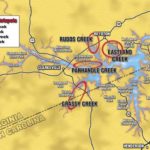
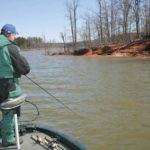
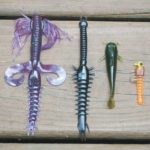
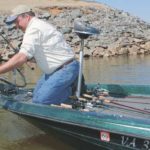
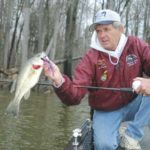
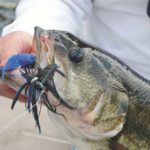
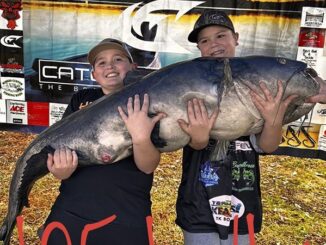
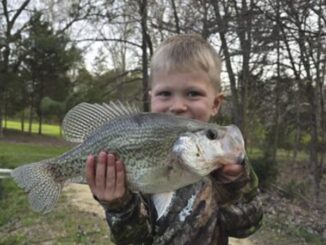

Be the first to comment